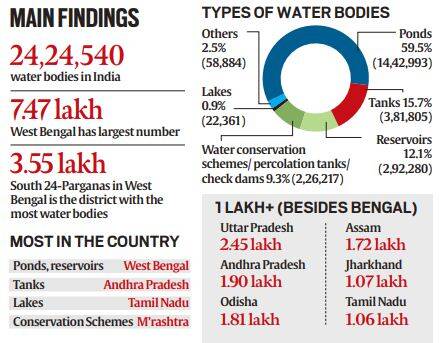What’s the News?
The Ministry of Jal Shakti conducted the first-ever census of water bodies across the nation.
Key Points
- The census was launched under the centrally sponsored scheme, ” in convergence with the 6th Minor Irrigation “Irrigation CensusCensus in order to have a comprehensive national database of all water bodies
- The census aimed to provide an inventory of India’s water resources, including natural and man-made water bodies like ponds, tanks, lakes, and more, and to collect data on the encroachment of water bodies
Conduction
- According to the report, “, i.e., paper-traditional methodologybased schedules, were canvassed both for rural and urban areas. A “village schedule”, “urban schedule” and “water body ” were canvassed, and a smart phone was used to schedule“capture latitude, longitude and photo of water bodies”
Findings
- 24,24,540 water bodies have been enumerated in the country, out of which 97.1% (23,55,055) are in rural areas and only 2.9% (69,485) are in urban areas.
- 78% of water bodies are man-made, whereas 22% are natural water bodies.
- 1.6% (38,496) water bodies out of all water bodies are reported to . Out of which 95.4% are in rural areas and have encroachedthe remaining 4.6% in urban areas.
- 8% of water bodies are in the domain of public ownershipof all public owned water bodies, maximum water bodies are owned by Panchayats, followed by State Irrigation/State WRD
- Among all water bodies, 9.6% are located in Tribal areas, 8.8% in Flood prone areas,7.2 % under Drought Prone Area Programme (DPAP), 2.0 % in Naxal affected areas, 0.7% under Desert Development Programme(DDP) and remaining 71.7% water bodies are located in other areas.
States and Water Bodies
- Top 5 States in terms of number of water bodies: West Bengal, which Uttar Pradesh, Andhra Pradesh, Odisha and Assam constitute around 63% of the total water bodies in the country.
- Top 5 States in terms of number of water bodies in urban areas: West Bengal, Tamil Nadu, Kerala, Uttar Pradesh and Tripura,
- Top 5 States in terms of number of water bodies in rural areas: West Bengal, Uttar Pradesh, Andhra Pradesh, Odisha and Assam.
Water body as per Water Census
- The Water Bodies: First Census Report considers “all natural or man-made units bounded on all sides with some or no masonry (e.g. work used for storing water for irrigation or other purposes industrial, pisciculture, domestic/ drinking, recreation, religious, ground water recharge etc.)” as water bodies.
- The water bodies “are usually of various types known by different names like tank, reservoirs, ponds etc
- According to the report, “A structure where water from ice-melt, streams, springs, rain or drainage of water from residential or other areas is accumulated or water is stored by diversion from a stream, nala or river will also be treated as water body.”
Did the census cover all water bodies that fit this definition?
No, Seven specific types of water bodies were excluded from the count.
- Oceans and lagoons
- Rivers, streams, springs, waterfalls, canals, etc. which are free flowing, without any bounded storage of water
- Swimming pool
- Covered water tanks created for a specific purpose by a family or household for their own consumption
- A water tank constructed by a factory owner for consumption of water as raw material or consumable
- Temporary water bodies created by digging for mining, brick kilns, and construction activities, which may get filled during the rainy season; and
- Pucca open water tanks created only for cattle to drink water.





